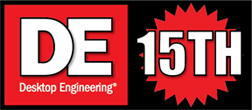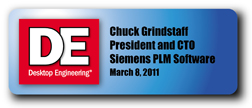March 8, 2011
 In 1995, when DE got ready to launch its premiere issue, the company now known as Siemens PLM Software was known by another name, UGS. Asked to reflect on the origin of the firm, the company’s president and CTO Chuck Grindstaff explained how two different but complementary companies—UGS and SDRC—came together in a merger in September 2001 to form the foundation of present day Siemens PLM Software.
In 1995, when DE got ready to launch its premiere issue, the company now known as Siemens PLM Software was known by another name, UGS. Asked to reflect on the origin of the firm, the company’s president and CTO Chuck Grindstaff explained how two different but complementary companies—UGS and SDRC—came together in a merger in September 2001 to form the foundation of present day Siemens PLM Software.
“On UGS side, we’ve always been focused on the integration of CAD and manufacturing—CAD and CAM (computer-aided manufacturing),” he said. “The SDRC side was more focused on analysis, CAE (computer-aided engineering).” UGS’s flagship product was its Unigraphics software, whereas SDRC was known for its I-DEAS software.

Unigraphics Version 10, recalled Grindstaff, marked the separation of “CAD data management, the PDM (product data management) that we have since been able to evolve into become Teamcenter, from our CAD offering. So we really broke apart CAD and PDM so those two can evolve at an accelerated pace.”
Grindstaff called Synchronous Technology, which marked Siemens PLM Software’s debut of a new hybrid CAD modeling mode, a mixture of history-free and parametric, “an important game changer” for “the way in which it was able to simultaneously work with subset equations of constraint, topology modeling and modification, and feature recognition.”
He believes “being able to harness the wisdom of the crowd, bring that back in a structured fashion, mine [insight] from it, and feed that back into requirements” make the role of social media a worthy focus for engineers and manufacturers.
To explain the concept of HD-PLM, which will manifest in the form of NX with HD3D, Grindstaff turned to Google Earth. “We have a very complex data set—all the aerial photos you need to navigate, with data on top of that. Where are gas stations? Restaurants? We have the same kind of ideas about navigating complex product data and manufacturing structures,” he said.
He has also been taking note of the swift takeover of mobile devices, like iPad and iPhone. “These devices can really change the way we interact with data stores,” he acknowledged. “You’ll be happy to learn that we’re just in the final phase of testing and releasing some applications for the iPad that reaches into our data stores and provide real-time feedback.”
To support mobile devices, which generally have smaller memory footprint and storage capacity, Siemens PLM Software plans to rely on its lightweight 3D format, JT.
For more, listen to my complete interview with Chuck Grindstaff in the podcast below:

Subscribe to our FREE magazine, FREE email newsletters or both!
About the Author
Kenneth Wong is Digital Engineering’s resident blogger and senior editor. Email him at [email protected] or share your thoughts on this article at digitaleng.news/facebook.
Follow DE





